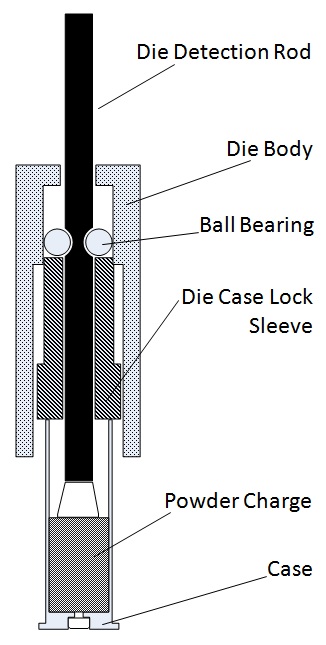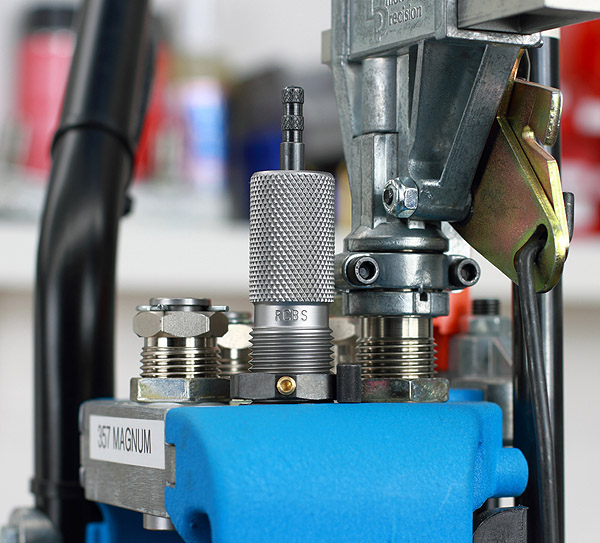Most reloaders have heard of the RCBS Lock-Out Die. This device will allow the reloading press to cycle normally when there is a proper powder charge, but will “lock up” the press if there is too much powder in the charge, or not enough powder in the charge (including no powder – a “squib load”). The die also allows the press to cycle normally when there is no case in the station where the lock-out die is installed. If you are like me, you may have wondered- OK, so how does this thing work? A fascinating device it is for sure!
In this series of articles, we’ll dig into the theory of operation, understand the parts that make up the assembly, learn how to use and adjust the die, and also do a tear down so that you can learn how to clean and adjust or fix the die.
So before we do any more talking, let’s take a quick look at a simplified diagram of the RCBS Lock-Out Die which we can use to understand how it works.

Let’s talk about the function of each of these parts:
Die Detection Rod
This is the component which moves upward and downward with the cartridge and contacts the top surface of the powder load via a nylon “foot” which is interchangeable based on the diameter of the case neck for the cartridge being loaded. In the actual assembly, there are 3 parts that make up this component – the upper rod, the lower rod, and the foot. The overall length of the rod is adjustable by means of threads where the upper and lower rods screw together. This adjustment is used to dial in the RCBS Lock-Out Die based on the powder level being checked.
Die Body
The die body is similar to the die bodies on most conventional reloading dies. This body is knurled on the exterior, and features conventional 7/8″ x 14 TPI threads which allows this die to be used on most any conventional reloading press.
Ball Bearings
The ball bearings move inward towards the center of the die and outwards towards the outer surface of the reloading die as the die components move. It is the ball bearings (two of them total) which “lock up” the die if the powder level is not correct when a case is present.
Die Case Lock Sleeve
The die case lock sleeve is actuated (moved vertically) by the case mouth. This part also acts as a carrier for the ball bearings via holes drilled in the side.
Parts not covered in this diagram
In addition to the primary components represented in this diagram, the following are also a part of the RCBS Lock-Out Die assembly:
- Spring clip – secures the die detection rod in the die body
- Circlip – keeps the die case lock sleeve from falling out the bottom of the die body\
- Compression spring – keeps the die case lock sleeve under spring pressure (downward) to assist in reset
- Die lock ring with set screw – used to lock die into place and retain setting when removed/replaced in the press
So now that we’ve taken a look at the components that make up the die, we can now talk about how this mechanism works. The basic theory of operation can be summed up as this: When there’s a case present, an “alignment of the planets” is needed for the press to cycle and not be locked up. What are the so-called planets here? These components are the die detection rod, the die body, the ball bearings, and the die case lock sleeve. If these components align, the ball bearings can move inward into the cutaway on the die detection rod, and that allows the die case lock sleeve to move upward in the die body. That’s it- if the die case lock sleeve can move upward with a case present, the press will cycle. If the die detection rod is not in the proper vertical position when the powder level actuates the rod, the ball bearings cannot move inward, and this will prevent the die case lock sleeve from moving upward.
The following diagram illustrates proper and improper powder levels, and how that translates to component alignment:

Let’s take a quick look at these scenarios from left to right:
Correct Powder Level
At far left, we see the correct powder level detected, and the die case lock sleeve has moved upwards inside the die body. This is possible because the ball bearings are “retracted” into the recess on the die detection rod.
Overcharge
The middle diagram depicts what happens when an overcharge is detected. The die detection rod is “too high” and this misalignment causes the ball bearings to interfere with the die body meaning that the die case lock sleeve can not move upward, and the press therefore locks up (powder is compressed by the foot).
Undercharge
The right-most diagram depicts an undercharge (or squib load if no powder is present). Much like the overcharge, the die detection rod recess is not aligned with the holes in the die case lock sleeve, and this prevents the upward motion of the die case lock sleeve.
So you might be thinking- what about when no case is present? In that case the die detection rod moves up when it contacts the press, and since the die case lock sleeve is not actuated, the press can cycle (die detection rod just moves up, then down).
There you have it- mysteries of the RCBS Lock-Out Die revlealed!
Next in this series, I’ll cover setup, operation and disassembly for this die.



















































































Did I read this correctly? Will this RCBS Lock Out Die work on a Hornady Lock N Load A.P. (Automatic Progressive) ?
Craig: Absolutely- in fact, it works best on the Hornady Lock-N-Load since you can quickly remove the die to inspect things if the die locks up (check powder level, or tear things down of you have an overcharge or squib.
Here’s a video showing the RCBS Lock-Out Die installed on the Hornady Lock-N-Load AP:
http://ultimatereloader.com/?p=780
What configuration would you recommend if you wanted to use a RCBS lock-out die with the Lee Loadmaster 5-station progressive system? Would you eliminate the factory crimp die? Is it possible or practical to try and seat a bullet in the fifth position (with the more limited access than in the fourth position)?
Thanks, Gavin!
– Harry
Harry- if you take a look at the “Lee Loadmaster Loading 45 ACP with RCBS Bullet feeder video:
http://ultimatereloader.com/?p=849
You’ll see the proper setup, but you’d put the RCBS Lock-Out Die in place of the bullet feed die.
Here’s the station breakdown:
1. Deprime (universal depriming die)
2. Sizer with decapping rod removed
3. Expand and charge
4. RCBS Lock-Out Die
5. Seat/Crimp
That should work well for you!
Thanks, Gavin!
I first used the Hornady Powder Cop on my LNL AP but eventually bought one of these lock-out dies. They are fantastic once you get them set up correctly, I use it for checking my TiteGroup loads for my .357 Magnum since it’s easier to accidentally get a double or empty charge. It’s more sensitive IMO than one would initially guess. A truly outstanding invention.
Will the lock-out die work with rifle cartridges such as .223?
Gavin,
Is there a way to make this Lock Out die work for loading .223? Or is there another version for rifle cases coming out from RCBS? I love this device for my pistol loads and would hate not to have this safety step available for rifle loads.
Thanks!
Gavin,
Is it possible to use the rcbs lock out die on a Lee classic turret press?
Is there a way to have an automatic bullet feeder, a lockout/cop die, AND separate seat and crimp operations? I’ve tried to set up seat and crimp together and just end up with mashed cases and a headache; however, without having six stations on the press this just seems impossible. So far I’ve tried with .223 and 7.62x54R with the same results, and now I’m going to be adding .45ACP to the mix. Was on an older Lee turret press and just bought a LnL-AP. (Haven’t even unpacked it yet, I’m a long-haul trucker and have practically zero time off)
I have completly eliminated problems with Crushing using a Free – Floating dies. Whidden has an excellent system and the Die Body is great On my 650 xl. you can do this to all die head stations.
I use this with every pistol die on my progressive press, easy to set up and no problems, that simple. Highly recommended to use
I’ve been reloading here in the UK for 35 years. I load 357 mag on my Hornardy Pro-Jector, which predates the LNL branding by many years and still works perfectly. I tried a powder check die some years ago, but every now and then you think “did I check that last round?”.
It’s therefore only one step away from visually checking powder with a flashlight. I realised you have to take the human element out of checking your powder. In use for five years now, my RCBS lockout die is my favourite die of the 50+ I own. An ingenious design and it works flawlessly with any progressive press.
You can just pop on those bullets, confident that every round is safe. If you’re wondering which checking die to buy, go for the lockout every time.
Gavin, I really enjoy your YouTube channel and blog, the ‘thinking man’s (and woman’s)’ reloading gear tests. Please keep it up!